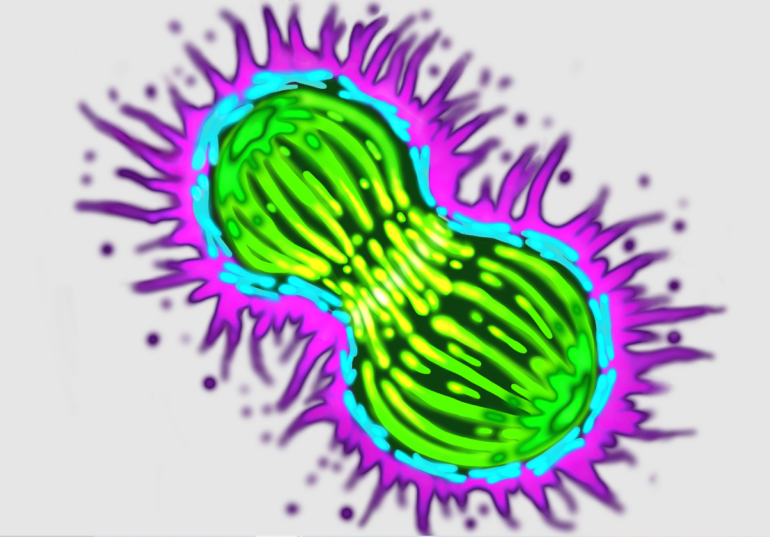Introduction
When we think of developmental biology, what comes to mind? Developmental biology, a constantly evolving field of study, largely focuses on processes involved in the reproduction, maturation, and differentiation of cells. Previous work in the field has generated a complex understanding of cellular division and replication. Now, fascinating cellular components are revealing more of what drives development. At UC San Diego, the Jin and Oegema/Desai Labs explore microtubules and cell contraction in cellular division, and how they impact model organism Caenorhabditis elegans’ ability to reproduce and survive the embryonic stage. These labs are exploring how mutations affect these cellular components and therefore impact an embryo’s ability to develop properly.
Microtubules and Temperature Sensitive C. elegans
At the Jin Lab, graduate researcher Kancheng Yin works with the Caenorhabditis elegans (C. elegans) model, or roundworm, to identify the effects of genetic variations on the development of the C. elegans in different temperature conditions. The genetic variations that they identified impact the tubulin proteins making up chains of microtubules within the cells of living organisms. Microtubules play an essential role in cell morphology as well as transporting cargo. Despite the importance of microtubules, there is more to be discovered about their ability to influence physical phenotypes such as temperature sensitivity. While wild type C. elegans develop and reproduce normally in 15-25ºC, the temperature sensitive phenotype resulted in C. elegans producing smaller and fewer offspring at 20ºC, and no progenies at all at 25ºC. Within this experiment, Yin works on identifying and mapping the genetic regulators for microtubule synthesis that result in this observed effect on C. elegans development.
Yin used a technique known as forward genetic screening, a method of discovering the genetic cause for a particular observed trait, to determine the mutation causing temperature sensitivity in C. elegans. This procedure first involved mutagenizing the model organism through the use of chemicals or radiation to purposely induce random genetic mutation. In this case, the Jin Lab utilized a chemical known for inducing single nucleotide base pair changes in the DNA sequence. Within the highly mutated worms, the researchers identified worms displaying the temperature sensitivity phenotype and proceeded with the screen by mating the EMS-treated mutated worms of interest with each other to make offspring referred to as the F1 generation. This F1 generation was then crossed with the wild type, unmutated worms to produce an F2 generation with a further diluted list of mutations to examine. From there, researchers examined the genomes of worms involved in the crosses and worked backwards to determine the specific mutation negatively impacting the development of C. elegans embryos under higher temperatures.
How did researchers determine the genetic cause of this particular conditional development? The researchers compared the genomes of previous generations in order to determine the single nucleotide mutations associated with the temperature sensitive phenotype. By comparing roughly 300 single nucleotide polymorphisms found in the genomes of the worms, the lab determined the gain-of-function mutation resulting in a single change in the amino acid sequence of the gene encoding alpha tubulin-1 (TBA-1), one of the alpha-tubulin proteins making up microtubules.
TBA-1 is in a class of proteins responsible for forming polymer chains that serve as microtubules in our cells. While multiple alpha-tubulin proteins serve the same purpose, their genetic sequences vary. Additionally, only a single base-pair change changing a single nucleotide causes this vastly different phenotype. Altogether, this discovery introduces interesting prospects for research regarding the unknown effects of microtubules, and how mutations within them can affect progeny viability, with other potential effects on development.
Cell contractility and embryonic C. elegans development
In addition to microtubules, organism growth also depends on cell division. At the Oegema/Desai Labs, post-doctoral researcher Aleesa Schlientz investigates the effect of contractile pressure on cell division in C. elegans. Contractility functions like cables on a suspension bridge by using tension; cables contract when pulled together and relax when pulled away. Contraction of cell surfaces can change the shapes of cells and ultimately tissues, and it also helps to cleave one cell into two during the end of cell division (cytokinesis). In the cellular environment, actin (a cytoskeleton protein) functions similarly to bridge cables, and myosin applies force to them.
Schlientz uses C. elegans as a model system for these contractility studies because she finds their contractile machinery to be highly similar to that of human cells. In both humans and worms, contractile movement operates based on regions of high and low contractility. The vertical “equatorial” band in the middle of a dividing cell employs high contractility, and the poles on each opposing end of the cell experience low levels of contractile pressure. This balance allows the cell to produce a symmetric cleavage site, and eventually two daughter cells with all organelles. But what causes these differences in cellular contraction? Schlientz researches the signaling that may create different levels of contraction in order to understand what confers a normal cytokinesis and embryonic development for C. elegans. The ability to correctly divide is vital for successful embryos, since chromosomal distribution depends on cytokinesis.
One type of signaling Schlientz works with involves the protein Cyk4, which helps activate chemical signals that tell the cell to contract at the equatorial region and split in two. To study this process, she injects wildtype parent worms with a mixture of plasmids. Some plasmids will create a break in the genome, and others contain a newly engineered “transgene” that codes for an altered Cyk4. This transgene integrates into the worm genome at the site of the break. After verifying that the offspring inherited this transgene, she injects the worm progenies with engineered double-stranded RNA (dsRNA) that becomes cut by enzymes in the cell. Cellular machinery then removes any of the original gene’s messenger RNA (mRNA) that matches this foreign dsRNA. Essentially, the transgene replaces the original gene that was disabled by a corresponding dsRNA. The embryo expresses only the engineered transgene, which affects its cellular development thereafter.
For Cyk4, Aleesa edits the transgene to produce new variations of residues on the protein. By changing the protein structure, she can see how the transgene affects signaling. She monitors the embryo’s phenotype at the site of contractility by watching multiple rounds of embryonic cell division under a microscope. Ultimately, either the transgene can lead to two healthy daughter cells that experience wild-type contractility, or it will lead to one big cell that does not divide– a nonviable embryo. This end result indicates how a certain Cyk4 structure impacts cellular contraction. Holistically, she’s investigating the molecular details of how signals directing contraction get from microtubules to the cell cortex, producing tension in the membrane. She’s discovered that other proteins associated with Cyk4 have the unusual ability to turn signal activators both off and on– conveying just how intricate this process can be.
Significance of Research and Future Directions
Both the Jin and Oegama/Desai labs are bringing new points of interest into the intersection between the fields of developmental and cellular biology.
As a lab focused primarily on neurobiology, the Jin Lab hopes to use this research to investigate how microtubules are involved in maintaining the shape and function of the neuronal axon over time. In particular, since Alzheimer’s Disease results in the breakdown of microtubules, this research opens up discussion on whether the destruction of microtubules is a causative effect in the onset of the disease.
At the Oegema/Desai labs, understanding the signaling that occurs during cell division allows for further exploration of intracellular communication. During cytokinesis, different cellular parts (like spindles and the cortex) “talk” to each other using signals. By understanding signaling between different cellular components, we can learn more about how all cells operate.
Between the microtubules studied by the Jin Lab and the cell contraction studied at the Oegema/Desai Labs, both research teams are making discoveries regarding the forces behind cell and organism development. By continuing investigations into the cellular machinery driving growth and division, we can fully understand the journey from embryo to organism.
Citations:
1 Conway, S.J. Developmental Biology: An Introduction and Invitation. J. Dev. Biol. 2020, 8, 11. https://doi.org/10.3390/jdb8030011

